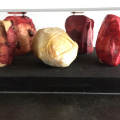Table of Contents
GENERATION-Z
installation biolab in Bozar labs
I am an artist, a beekeeper and a herbalist. My work is a tight coupling between art and science. It draws on the edge of biology, ecology and technology. My research starts from long-term field observations which I translate in factual and/or fictional stories.
My huge collection of eco-data (video, audio and environmental sensor data) is the basis for the creation of techno-organic objects that are a combination of digital fabrication and craftsmanship.
My (often large scale) installations reflect both the problem and the possible solution, and they are often build upon multispecies collaborations.
lighttable with biolab installation
intelligent guerilla beehive
Intelligent Guerilla Beehive (double take) – 150 x 38 x 38 / sculpture with cellulose skin and electronics in plexiglass box on metal pedestal.

caption:
The Intelligent Guerilla Beehive is a bio-art project on the edge of art and science. It combines in a radical way smart materials, biomimetic forms and biotechnology, and it evokes issues of sustainability and biodiversity. This radically new device is inspired by the intelligence, complexity and self-organisation of bee colonies, and it tackles a domain where human and non-human actors collaborate to maintain the resilience of an ecosystem in decline.
The Intelligent Guerilla Beehive is a shelter for swarming bee colonies, prototyped out of organic materials and powered by green energy. It is a bio-technological sensing device that measures the health of the environment, and as well it monitors the wellbeing of bee colony living inside. Bacteria -living in a biofilm on the outer skin of the beehive- send out warnings by adapting their colour to different degrees of environmental contamination. Bacteria living on the inner side of the beehive’s skin support the bees in their struggle against the Varroa mite.
wunderkammer on the table
caption:
The wunderkammer is composed of a series of strange objects. They are presented on a large laboratory table. Their forms are inspired by nature, and the organic materials they are made of are grown by bacteria or made out of vegetal matter. Every artifact is the outcome of a particular experiment. Most of the items are studies for different parts of the Intelligent Beehive project: the development of a mobile shelter for homeless honeybees.
microbial skins, vegetal dye
I will hang these (delicate) skins on nylon wires fixed on the lighting-rail, in front of the window.
They will NOT be presented in this lightbox. Handle with care!

caption:
Series of microbial skins, grown in a symbiotic action by Acetobacter xylinum bacteria and yeast cells. These skins are coloured with vegetal dyes: Indigo Blue, Black Oak Gall, Campèche, Hibiscus, Stinging Nettles, Cochineal. All vegetal dye matter was grown in de rooftop laboratory, some of the dyes are processed from organic matter collected during travels (Black Oak Gall, California – Cochineal, La Gomera)
genesis of a microbial skin, video
video 6'14“ (presentation on wall-mounted monitor)
caption:
In her Laboratory for Form and Matter, AnneMarie Maes works on long term research projects. Her laboratory is an open environment for experimentation, a space for contradiction, criticism and evaluation. In the Intelligent Guerilla Beehive project, she combines organic components with living systems and bacteria to create artifacts for the future. She makes micro-organisms grow organic biofabrics and she researches how these fabrics can be enhanced and made useful through embedded electronics and living technology. Navigating between blueprints and ‘Proof of Concept’, her projects and objects can be classified as ‘Future Archaeology’: fragments of a Forgotten World as well as fragments of a World To Come.









